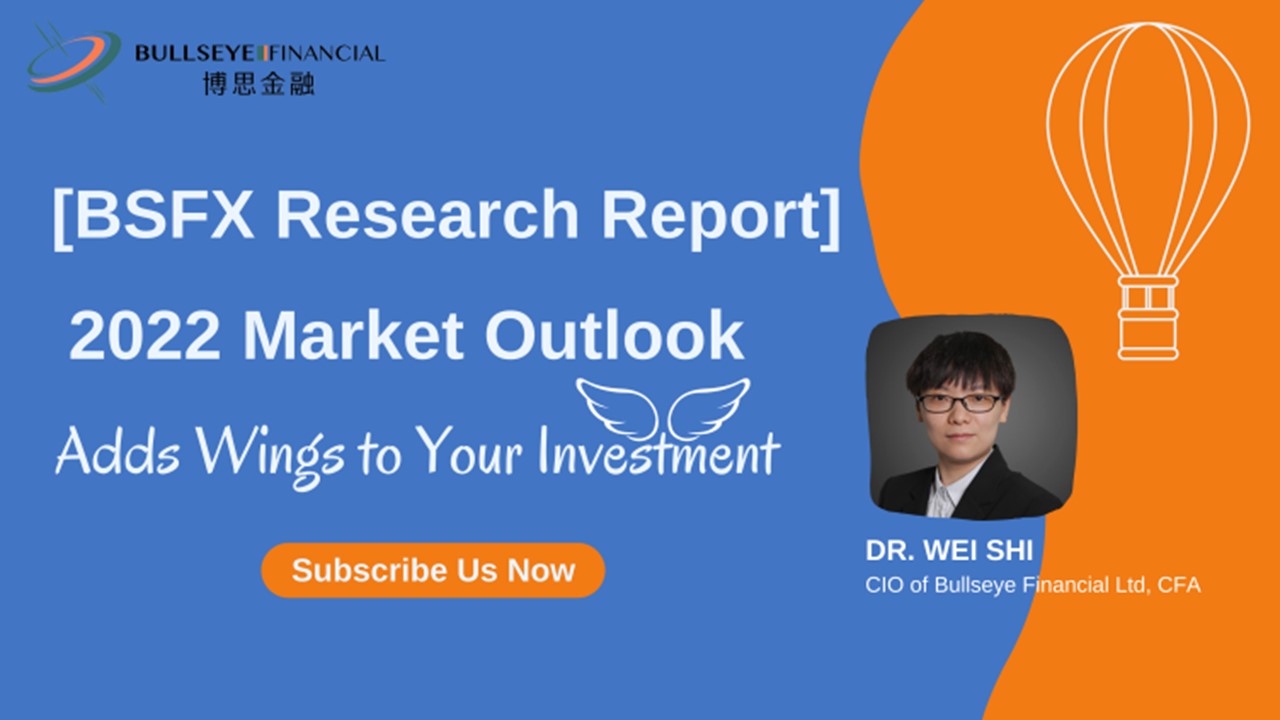[BSFX Research Report] 2022 Market Outlook Adds Wings to Your Investment
In our 2021 year-end review, we took a look at the significant events that financial markets have experienced in the past year. In the following article, we share with you the investment strategy and achievements of our BSFX team in 2021. With the arrival of the brand New Year 2022, we also hope to share with you the team's outlook on the capital market in the New Year, and discuss the investment layout of the New Year to facilitate your investment road in 2022.
Overall, BSFX remains optimistic about the capital markets in 2022, but believes that this year is more uncertain than the previous year and investors may need to lower expectations for returns and play a cautious defensive strategy in the current year, particularly in the first half. In addition, the diversified investments in the global market seem more important.
The Fed's dove-to-hawk attitude as a result of the stubbornly high inflation
When it comes to the biggest risks to the market consensus in 2022, the belief in high inflation and the Fed's dove-to-hawk attitude as a result must be highly electable. At the Fed's regular meeting at the end of November, Mr. Powell had for the first time abandoned the notion that inflation was transitory, arguing that it would last until 2023. To control inflation, the Fed will speed up tapering. The talk of a rate rise was then raised - the dot plot showed that most Fed officials saw at least three rate rises coming in 2022. This series of actions are also seen as the Federal Reserve from the previous "extreme dovish" to hawkish.
In our last article, we looked in detail at the causes of high inflation, both on the supply side and the demand side. We believe that a gradual tightening of monetary policy led by accelerated tapering and interest rate hikes can control inflation from the demand side to some extent, but will do little to help the supply side (the supply chain crisis caused by COVID-19). As a global issue, the supply chain crisis is subject to the COVID-19 and the epidemic prevention measures in various countries, with a high uncertainty. In addition, a variety of other factors, such as Mexico's announced oil supply cuts, Russia's conflict with Ukraine, and rising rents due to rapidly rising house prices, will continue to intensify the high inflation for a long time.
We have already seen the determination of the US government and the Fed to control inflation, so if inflation does not fall as expected in the first half of 2022, the Fed will remain hawkish, or even become more hawkish, and the market will continue to suffer. On the other side of the ocean, the European Central Bank has been more dovish, even as it faces high inflation. We believe that adding the right assets in Europe, such as crude oil, to the portfolio can serve to diversify risks in a year of high uncertainty.
Historic high indexes and obvious market differentiation
If you invested in the U.S. stock index over the past year, you did well. The S&P 500 is up more than 27% in 2021, and the Dow Jones Index and Nasdaq Index are also seeing decent gains. However, statistics show that since last April, 51% of the market's gains have come from just five stocks - Apple, Google, Microsoft, NVIDIA, and Tesla. Most stocks have made no progress since last March, or are in a bear market. Toward the end of the year, the index moved steadily higher under the strong protection of several tech giants, even though many stocks were "dead to rights".
As a result, the market seems to be in a "dilemma" at the beginning of 2022. On the one hand, the index has repeatedly made record highs, but on the other hand, it is afraid to risk on the dark clouds of bad news (high inflation, surging COVID-19 infections, etc.). The consensus seems to be looking for a 10%-15% market correction, along with the big tech stocks that had been protecting them. When market risks are fully released, valuations are corrected, and the market is basically stable and rising, funds may enter the market again.
We expect this new round of risk on pattern to be seen in the second half of 2022.
Listening to views from investment banks
As usual, let's hear what the major investment banks have to say about the market in 2022.
Analyst Targets for S&P 500 by End of 2022

Of the six investment banks, all but Bank of America are bullish:
- Fundstrat anticipates the S&P 500 will hit a new high in 2022. There could be a correction of at least 10% in the first half. But the second half will reverse the trend and rebound strongly.
- Goldman sees the S&P 500 continuing to rise in 2022, but not the strong returns of the past two years, and advises investors to exercise appropriate risk management.
- Citibank expects U.S. stocks to benefit from the continued strong growth in corporate profits in 2022, but warns of potential headwinds to valuations from Fed tightening.
- J.P. Morgan believes the tech sector, represented by FAAMG, will remain fundamentally strong, but higher interest rates will put multiple pressures on the sector as a whole.
- UBS is bullish on the Russell Midcap index, arguing that mid-cap stocks, which underperformed last year, will outperform large-cap stocks in terms of earnings.
- Bank of America, the lone bearish investment bank, sees inflated expectations, a higher discount rate, rising capital spending but slowing consumption as factors that will affect U.S. stocks in 2022. Subject to the interest rate hikes, growth stocks are still not optimistic, and value stocks will continue to rotate.
Finally, BSFX wishes all investors a more successful and profitable 2022.
Author: Dr.Wei Shi (CIO of Bullseye Financial Ltd, CFA)






